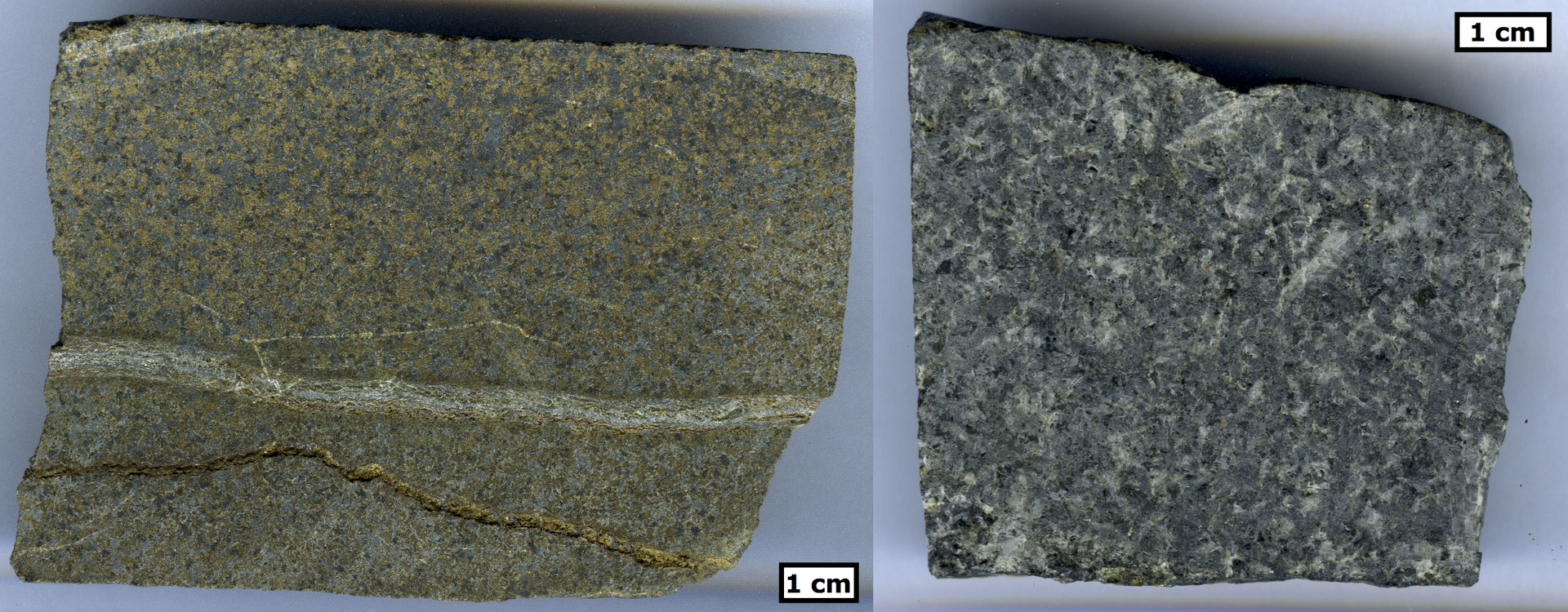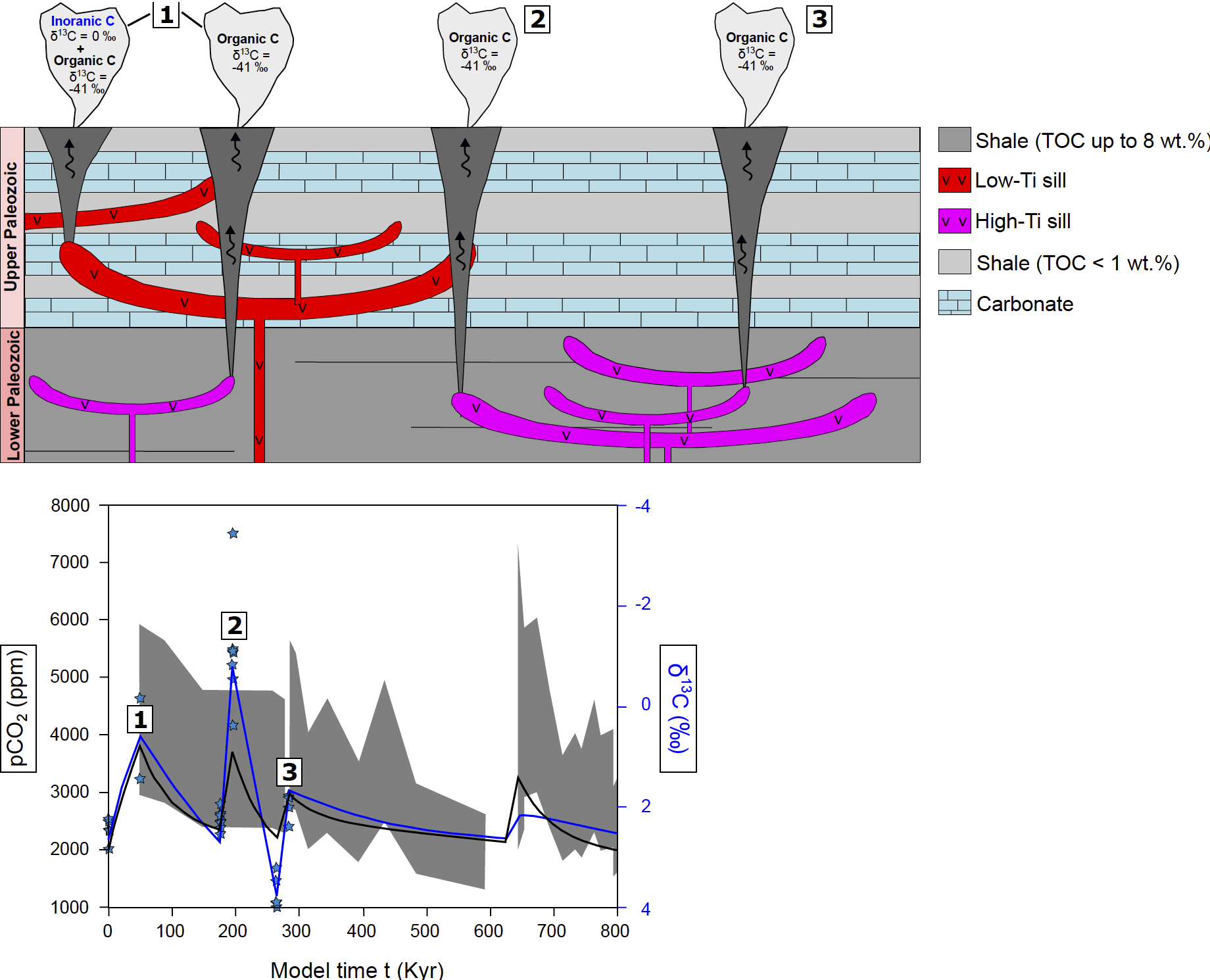
The Earth’s climate has remained relatively stable over the course of the last 4 billion years, allowing life to continue and evolve. However, occasionally the climate deviates from its normal stable state. In extremely rare cases, global warming of several degrees (°C) can occur in just a few thousand years, which is extremely fast in an Earth history perspective. Such rapid climate change events often coincide with the formation of Large Igneous Provinces (LIPs). These LIPs are events that emplace huge volumes of magma into the shallow crust and lavas at the surface. This close temporal correlation between LIP formations and rapid climate change has led to the hypothesis that carbon released during such massive volcanism can be responsible for rapid climatic changes.

One of the largest known LIPs is the Central Atlantic Magmatic Province (CAMP) that formed ~201 million years ago. The emplacement of CAMP occurred at the same time as the end-Triassic crisis, which was one of the largest mass extinctions in Earth history due to major changes to the carbon cycle and extreme global warming. The evidence for carbon cycle changes includes: 1) an increase in the atmospheric concentrations of CO2, indicating a large increase in the volume of carbon released to the atmosphere; and 2) several negative carbon isotope excursions, suggesting that the carbon sources were isotopically light (i.e. a higher ratio of 12C compared to 13C).

The formation of CAMP would have caused significant changes to the carbon cycle. Volcanoes release large volumes of CO2 to the atmosphere during eruptions. However, carbon cycle modeling has suggested that the release of volcanic carbon from CAMP cannot have caused the negative carbon isotope excursions1-3, because volcanically derived carbon is too isotopically heavy (13C-rich). However, another large source of carbon comes from magma intrusions into the crust. The heat from these intrusions leads to the contact metamorphism of surrounding rocks, which in turns can produce volatiles that degas to the surface. The carbon generated through thermogenic processes is isotopically light (12C-rich) as the metamorphosed sediments are often rich in organic material preserved in shales and hydrocarbon reservoirs.
For CAMP, there is compelling evidence that huge volumes of magma were intruded into the organic-rich sedimentary basins of central Brazil4, suggesting that these events may be responsible for the negative carbon isotope excursions observed in the rock record. However, until now the contact metamorphism from CAMP intrusions and its relation to the end-Triassic crisis have not been explored from a carbon cycle approach.

In this study, the CEED researchers have tested the effects of releasing thermogenic carbon from CAMP by using the Long-Term Ocean-Atmosphere-Sediment CArbon Cycle Reservoir (LOSCAR) computer model. Detailed and realistic carbon emission scenarios were developed to replicate observed proxy data for climate change, such as atmospheric CO2 concentrations and carbon isotopes from geological records. The model simulations show that ~ 24,000 billion tons of carbon, with a 50/50 contribution of volcanic and thermogenic carbon, best replicates the end-Triassic proxy data. These results suggest that thermogenic carbon generated from contact metamorphism of organic-rich shales and hydrocarbon reservoirs around CAMP intrusions represents a credible source for the negative excursions.
The study strengthens the hypothesis that thermogenic gas release is especially important during episodes of major carbon cycle changes. It is a key factor in the relationship between the formation of CAMP and the end-Triassic crisis, and potentially the relationship between LIPs and environmental crises in general. By improving our understanding of what causes rapid and major climate change events, we can improve our predictions of the future, now that we are causing a rapid warming event of our own.
Thea H. Heimdal, Morgan T. Jones, and Henrik. H. Svensen. (2020). Thermogenic carbon release from the Central Atlantic magmatic province caused major end-Triassic carbon cycle perturbations. Proceedings of the National Academy Sciences of the United States of America (PNAS).
Author contact: Thea H. Heimdal t.h.heimdal@geo.uio.no
References 1Beerling, D. J., & Berner, R. A. Biogeochemical constraints on the Triassic‐Jurassic boundary carbon cycle event. Global Biogeochemical Cycles, 16(3) (2002). 2Bachan, A., & Payne, J. L. Modelling the impact of pulsed CAMP volcanism on pCO2 and δ13C across the Triassic–Jurassic transition. Geological Magazine, 153(2), 252-270 (2016). 3Paris, G., Donnadieu, Y., Beaumont, V., Fluteau, F., & Goddéris, Y. Modeling the consequences on late Triassic environment of intense pulse-like degassing during the Central Atlantic Magmatic Province using the GEOCLIM model. Climate of the Past Discussions, 8(3), 2075-2110 (2012). 4Heimdal, T.H. et al. Large-scale sill emplacement in Brazil as a trigger for the end-Triassic crisis. Scientific Reports, 8, 141 (2018). 5Pálfy, J. et al. Carbon isotope anomaly and other geochemical changes at the Triassic-Jurassic boundary from a marine section in Hungary. Geology, 29(11), 1047-1050 (2001). 6Galli, M. T., Jadoul, F., Bernasconi, S. M., & Weissert, H. Anomalies in global carbon cycling and extinction at the Triassic/Jurassic boundary: evidence from a marine C-isotope record. Palaeogeography, Palaeoclimatology, Palaeoecology, 216, 203-214 (2005). 7Galli, M. T., Jadoul, F., Bernasconi, S. M., Cirilli, S., & Weissert, H. Stratigraphy and palaeoenvironmental analysis of the Triassic-Jurassic transition in the western Southern Alps (Northern Italy). Palaeogeography, Palaeoclimatology, Palaeoecology, 244, 52-70 (2007). 8McRoberts, C. A., Furrer, H., & Jones, D. S. Palaeoenvironmental interpretation of a Triassic–Jurassic boundary section from Western Austria based on palaeoecological and geochimical data. Palaeogeography, Palaeoclimatology, Palaeoecology, 136, 79-95 (1997). 9Schaller, M. F., Wright, J. D., & Kent, D. V. Atmospheric PCO2 Perturbations Associated with the Central Atlantic Magmatic Province. Science, 331(6023), 1404-1409 (2011). 10Schaller, M. F., Wright, J. D., Kent, D. V., & Olsen, P. E. Rapid emplacement of the Central Atlantic Magmatic Province as a net sink for CO2. Earth and Planetary Science Letters, 323-324, 27-39 (2012).




